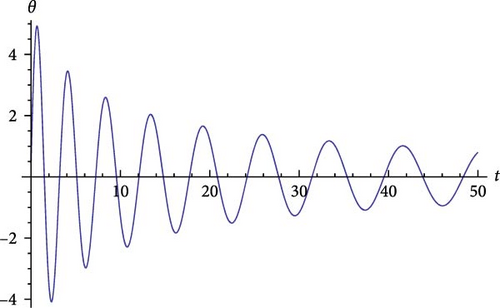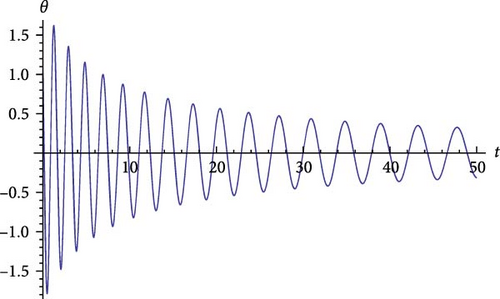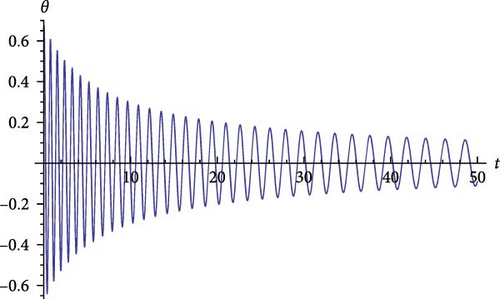Solutions of Bessel’s Differential Equations by Variable Change Method
Abstract
In this article, the solutions of Bessel’s differential equations (DEs) by variable change method are formulated. To do so, we have considered the first and second kind of Bessel’s functions which are obtained as solutions of Bessel’s equations and it is used to determine the solutions of the lengthening pendulum (LP). To solve the given equations, we have used Frobenius theorem and the gamma function and hence, apply the obtained results to solve the LP. The finding reveals that Bessel’s functions establish the solutions of LP equations. The solutions obtained for lengthening the pendulum are illustrated graphically using the computer software of MathLab. The graphical results show that the sinusoidal wave natures are compressed or extended based on the chosen parameter k. Finally, it is concluded that the obtained method gives an effective, efficient, and systematic method.
1. Introduction
It has been found many important applications in the real physical world using the second order differential equations (DEs). So, many researchers have found different methods to get their solutions. Among those few of them are: finite element method [1], collocation method [2, 3], fractional differences and derivatives mittag-leffler kernels [4, 5], computational algorithm [6], reproducing kernel hilbert space (rkhs) method [7] and reduced differential transform (RDT) method [8]. Bessel’s equations are second order DEs whose solutions are very important in many applications of science and engineering. The solutions to the Bessel equations are Bessel functions. Bessel’s functions were studied by many researchers [9, 10]. Bessel’s functions are shown by using the function of zero order as a solution to the problem of an oscillating chain hanging at one end and employed Bessel’s functions of both the integral orders and zero orders in an analysis of vibrations of a stretched membrane illustrated by Niedziela [9], Musa [10], and Baricz [11]. It also arises as a result of determining separable solutions to Laplace’s equation and the Helmholtz equation in spherical and cylindrical coordinates [12]. Hence, Bessel’s functions are great important for many problems of mathematics and mathematical physics [13–15].
The first feature to be recognized as unifying the various special functions were that each one can be linked to the solution of a second order DE with none constant coefficients [10, 16]. Lengthening pendulum (LP) is a pendulum whose length increases at its motion and the length is always given as a function of time. The equation of angular motion of a LP in the form of radial is a linear second order ordinary differential equations (ODEs) [17] and it can be solved by changing to Bessel’s DE by using variable change method. The Lagrange’s work on elliptical orbits for the first time applied and noted as Jz,n and further modified to Jn(2z) [18]. Appropriate development of zeros, modified Bessel functions, and the application of boundary conditions has been briefly discussed [19]. The solutions to this equation gives the Bessel functions of first and second kinds, usually denoted by Jn(x) and Yn(x), respectively.
For our common understanding, the LP involves some change of variables to give a relationship with the Bessel’s equation. The approximation of the first-order Bessel functions (v = 1) of both types along with their zeros are being obtained analytically with a good accuracy as a result of the appropriately chosen associated initial values, and they are extended to the neighboring orders v = 0 and 2 by the recursion relations. The required initial values are also being studied and as a result, the semi classical approximation method which is normally used for the quantum mechanical and optical waveguide systems is applied to the classical LP system successfully [14]. Bessel function is a more difficult interpretation than sinusoidal function [14, 20]. The order of the Bessel equation play a great role on the solutions of the equations and solving such equations using change of variable method with regard to the Bessel’s equation [21]. Now, it can be interesting to use the other convection method named a change of variable method to find solutions of Bessel’s DEs. So in this article, we consider change of variable method and solve the equation of angular motion of a LP using the Bessel’s DE of order k, where k is any positive real number.
2. Mathematical Formations and Preliminaries
2.1. Preliminary Terms
Definition 1. Bessel’s DE of order k is second-order ODE of the form:
Definition 2. Bessel’s DE of order zero is the second-order ODE of the form:
Remark 3. Frobenius’ Theorem. If t0 is a regular singular point of the second order DEs of the form:
Definition 4. The Gamma Function. Let z be a complex number such that Re(z) > 0 then, the gamma function (Γ) is:
2.2. Solution of Bessel’s DE
By using Frobenius series solution method and the gamma function, we have solutions of Bessel’s DE.
2.2.1. Bessel’s Function Jk(x) of the First Kind of Order k
2.2.2. Bessel’s Functions yk(x) of the Second Kind of Order k
- •
Asymptotic of Bessel functions
- •
General solution of the Bessel’s equation
2.3. LP
- i.
Bessel’s equation and Bessel functions are defined.
- ii.
Equation of angular motion of LP is stated based on physical model of the pendulum.
- iii.
Changing equation of angular motion of the pendulum into Bessel’s equation by variable change method.
- iv.
The equation of motion of the pendulum is changed to the Bessel’s equations by relating the coefficients of the equations.
- v.
The transformed Bessel’s equations are solved by above specific method.
- vi.
Finally, the transformed Bessel’s equations solutions are determined and analyzed.
3. Results and Discussion
3.1. Power Series Solution of Bessel’s DE
Theorem 5. Bessel’s Function of the First Kind. The first kind of Bessel’s function is a solution of the Bessel equation, when k is positive and considering v = k.
Proof. Equation (20) becomes:
Corollary 6. Bessel’s function of the first kind for half integer values of k.
For , Equation (35) becomes:
Proof. Equation (35) can be written as:
Theorem 7. Bessel’s Function of the Second Kind. Bessel’s function of the second kind is a solution of Bessel’s equation when k is nonintegral negative real number (v = −k) and is given by:
Proof. When k is nonintegral:
- a.
Since k is not an integer, sin(kπ) ≠ 0. In the above discussion, we have seen that Jk(x) and J−k(x) are independent solutions and y(x) is the linear combination of Jk(x) and J−k(x). Therefore, Jk(x) and y(x) are independent solutions of Bessel’s DE.
- b.
The second kind of Bessel’s function is defined as solution of the Bessel’s equation with the following asymptotic.
()Let()Equation (53) can be expressed as:()Since both π and k are constants, and are also constants. Therefore, Equation (54) can be written as:()where()Then, substitute Equation (56) into Equation (13) and we have:()As we know, the general solution is a linear combination of the first and second kinds of Bessel’s functions, which is given by:()where c1 and c2 are constants.
3.2. Changing the Equation of Angular Motion of a LP to a Bessel’s Equation
We are going to apply a simple change of variable method to solve the equation.
Theorem 8. The equation of angular motion of a LP can be changed to Bessel’s equation and hence, transformed to the equation of angular motion which has the form of Equation (14), can be changed to a Bessel’s equation of the form:
3.3. Solution of Equation of Angular Motion of a LP
Theorem 9. Relations between coefficients of Equation (1) and (14) and variables of the equation of angular motion of the pendulum θ can be expressed in terms of y, k, and coefficients of equation of the pendulum. Again, t can be expressed by x and coefficients of the equation of the pendulum.
Proof. Substitute Equation (71) into Equation (60), we have:
Theorem 10. Derivatives of the First and Second Kind of Bessel’s Functions. The derivatives of Equations (10) and (11) can be found using the usual method of derivation and properties of the gamma function and is given by:
Proof.
Then, from the properties of the gamma function, we have:
as n → ∞, therefore,
Then, Equation (87) becomes:
3.4. Illustrative Examples
This section contains some counter examples of solution of the equation of angular motion of a LP for fixed values of the constants and different values of k.
Example 11. Let k = 0.3 for our general solution:
Example 12. Assume k = 0.5 and the initial values are kipping as Example 11, a = 0.5 m, b = 0.1 m/s, and g = 9.8 m/s2.
Then, the general solution in its simplified form becomes:
Example 13. Let k = 1 and keep the values of initial conditions and gravitational acceleration as Examples 11 and 12. The general solution can be simplified as:
Example 14. Let as consider the value of k to be large (k = 2) compared to the above examples, and a = 0.5 m, b = 0.1 m/s, and g = 9.8 m/s2. Then, the general solution can be simplified as:
3.5. Graphical Results
Graphical results are solutions of the equations of angular motion of a LP for different values of k. These graphs clearly show the effect of k on the solution of equation of a LP, which is given by Equation (103).
Figure 1 shows the graph of the solution given in Example 11 which is the Bessel’s function whose variables y and x are changed to θ and t, respectively.

Figure 2 shows the graph of the solution given in Example 12 which is the Bessel’s function whose variables are changed to the variables of equation of a LP.

Figure 3 shows the graph of the solution given in Example 13 which is a Bessel’s function describes the motion of a LP for some initial values and a constant k.

Figure 4 shows the graph of the solution given in Example 14 which is the Bessel’s function describes the motion of a LP for some initial values and the order of the Bessel’s equation.

4. Conclusion
In this article, the solution of the equation of angular motion of a LP using the Bessel’s equation has been studied. The change of variable method is used to change the equation of a LP to the Bessel’s equation and the solutions of Bessel’s equation are applied to find the proposed problem. The findings show that a new method to change the equation of the motion of a LP to the Bessel’s equation using a change of variable method is clearly shown. In the results, the obtained solutions reveal that the sinusoidal wave nature type achieved in compressed and extended form. The extended or compressed form of sinusoidal wave nature depends on the parameter k. Moreover, the result of the findings are illustrative by some examples and shown graphically. Hence, the obtained result shows that the Bessel’s equations have a great advantage to find the solution of the angular motion of a LP with an effective method.
Conflicts of Interest
The authors declare no conflicts of interest.
Author Contributions
Conceptualization, methodology, software, data curation, and writing–original draft preparation: Beyalfew Anley and Daba Meshesha Gusu. Validation: Daba Meshesha Gusu and Tolosa Nigussie. Formal analysis, investigation, writing–review and editing, and visualization: Beyalfew Anley, Daba Meshesha Gusu, and Tolosa Nigussie. Supervision: Daba Meshesha Gusu. All authors have read and agreed to the final version of the manuscript.
Funding
The authors did not receive any funding to do this article.
Open Research
Data Availability Statement
Data availability is not applicable to this article as no new data were created or analyzed in this study.




